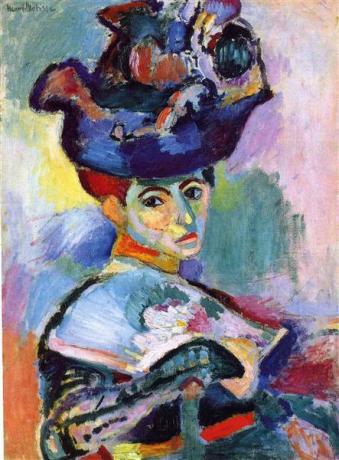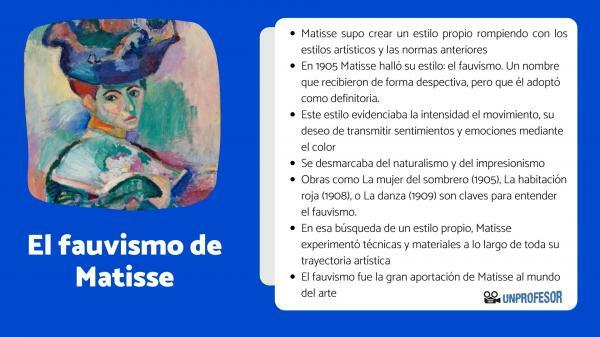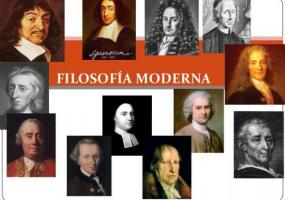Henri MATISSE's FAUVISM

The fauvism It is one of the first avant-garde movements to flourish in France in the early 20th century. Henri Matisse (1869-1954) he was the leader of this movement, breaking with Impressionism and with the more traditional and objective methods of observation and perception of reality. Matisse and André Derain (1880-1954) introduced unnatural colors and more vivid and intense brushstrokes as a way of giving way and capturing subjectivity the painter on the canvas.
In this lesson from unPROFESOR.com we offer you a summary of the relationship between Fauvism and Matisse as the main representative of the movement.
The fauvismstarted in 1905, the year in which Matisse and Derain presented at the Salon d'Automne in Paris the works that both had painted in the fishing port of Collioure. A summer in which Matisse made such an iconic work as "The woman with the hat", work that inspired the term fauve (wild or wild beast) with which the critic Louis Vauxcelles described them in his review of the exhibition.
Henri Matisse, as head of the Fauve movement, defined a series of basic characteristics and an artistic approach that he shared with a group of artists who, despite not having a definitive program, did agree on:
- Experiment with the various Post-Impressionist styles of artists such as Vincent van Gogh, Gauguin and Cezanne, and the neo-impressionism of Seurat, Cross and Signac.
- Reject the three-dimensional space traditional.
- Search instead for a new pictorial space defined by the movement of color planes.
- Breaking with Impressionism.
- Paint with bold brush strokes and use vibrant and intense colors, as they come out of the paint tube.
The fauve group of artists never formed a solid block, being a flexible movement. Most of them considered Fauvism to be a learning stage, transitional. Thus, in 1908, and given the interest that Paul Cézanne's vision aroused on the order and structure of the nature, many of them rejected the emotional turbulence of Fauvism in favor of the logic of cubism.
Braque became a co-founder with Picasso of Cubism. Derain, after a brief approach to Cubism, became a more classical style painter. Matisse was the only one who remained within Fauvism, achieving a balance between the emotional and what he painted.
Fauvism was compared to german expressionism since they agreed in some aspects:
- Both used bright colors and spontaneous brushstrokes.
- They were indebted to the same late 19th century sources, especially Van Gogh.
On the other hand, the main difference between the two movements is that the Fauvists were more concerned with the formal aspects, while the German Expressionists were more emotionally involved in their themes.
In addition to Matisse and Derain, the group of fauve artists also stands out Maurice de Vlaminck (1876-1958), which is called as natural fauve since it used very intense colors as part of its exuberant character. Vlaminck adopted the fauve style after seeing the second major retrospective exhibition of Van Gogh's work at the Salon des Indépendants in the spring of 1905, and the Fauve paintings produced by Matisse and Derain in Collioure.
André Derain he stood in an intermediate zone between the intense Vlaminck and Matisse, much more controlled. He worked with Vlaminck in Chatou, near Paris, on and off from 1900 onwards forming part of the so-called "School of Chatou", and also spending the productive summer of 1905 with Matisse in Collioure.
Other important Fauvists were Kees van Dongen, Charles Camoin, Henri-Charles Manguin, Othon Friesz, Jean Puy, Louis Valtat, and Georges Rouault. A group they also joined in 1906 Georges Braque and Raoul Dufy.

Image: The Woman in the Hat by Matisse
Matisse knew how to create a own style breaking with the artistic styles and the previous norms, at the same time that he turned to innovate and continue working despite the limitations that the disease imposed on him. And it is that Matisse discovered his vocation as a painter during a period of convalescence after an operation for appendicitis. The painter, born in Le Cateau-Cambresis, a town in northern France and famous for his fabrics, had graduated as a lawyer, eventually practicing as such.
But, after recovering and deciding on painting, Matisse began his studies at the School of Fine Arts in Paris. It was the year 1892 and at school he learned to paint in the classic and traditional style, in addition to studying how to work with light and color from artists such as William-Adolphe Bouguereau and Gustave Moreau, who followed that classical tradition.
Along with these influences and learnings, Matisse was also inspired by other modern and innovative painters such as Vincent Van Gogh, Paul Cézanne, or Paul Gauguin. Thus, Matisse experimented with both naturalism and expressionism in search of that style of his own that he sought, in addition to possessing a special taste for the color acquired in his childhood and youth between the colorful luxury fabrics of Bohain and the woolen fabrics of Le Cateau-Cambrésis.
It would not be until 1905, after his collaboration with Derain painting that summer at Collioure, when Matisse finds his style, the fauvism. A name that they received in a derogatory way, but that he adopted as a defining one. A word that showed the intensity of the movement, his desire to convey feelings and emotions through color and uncheck naturalism and impressionism. Works like The Woman in the Hat (1905), The Red Room (1908), or The Dance (1909) they are key to understanding Fauvism.
Trips to countries such as Morocco, Spain or Tahiti and his taste for exoticism inspired both themes and the desire to achieve tonal harmonies and unite color and line. In this search for his own style, Matisse he experimented with techniques and materials Throughout his entire artistic career, Fauvism being his great contribution to the world of art.




